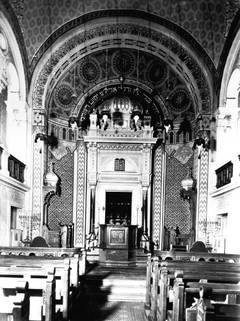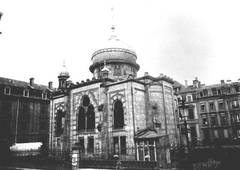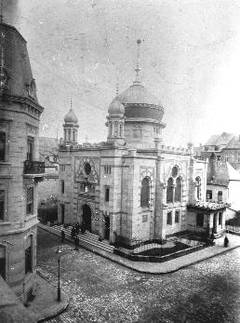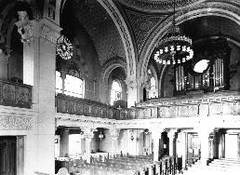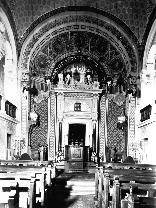Our History
Our History
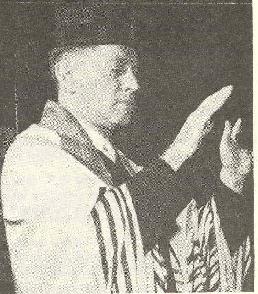 Ramath Orah has a unique legacy among Upper West Side synagogues. Founded in 1941 by Rabbi Dr. Robert Serebrenik, the synagogue’s original congregation was comprised of sixty one refugees from Luxembourg who escaped the Nazi occupation under extraordinary circumstances. When they arrived in New York they immediately began the work of establishing a congregation in their new home. By 1942, they had founded Congregation Ramath Orah, naming it after the community they'd left.
Ramath Orah has a unique legacy among Upper West Side synagogues. Founded in 1941 by Rabbi Dr. Robert Serebrenik, the synagogue’s original congregation was comprised of sixty one refugees from Luxembourg who escaped the Nazi occupation under extraordinary circumstances. When they arrived in New York they immediately began the work of establishing a congregation in their new home. By 1942, they had founded Congregation Ramath Orah, naming it after the community they'd left.
See Pictures of the Historic Luxembourg Community
Read an expanded history of our Luxembourg Heritage
Read historical excerpts from our archives
See a list of our distinguished past rabbis and presidents

On the Registry of Historic Places

Read about our nomination to the National Register of Historic Spaces.
History of Ramath Orah's Building

 When you visit Ramath Orah, you might notice the organ pipes adorning the walls in the front end of the sanctuary. The organ pipes reveal the building's interesting history. Before housing a Jewish congregation, the building at 110th and Broadway was designed to house a Unitarian congregation. After running short on funds, the church halted construction and moved locations. Pictures of the original building design show that the building was originally planned to be twice its current size and to include a cupola tower. The Jewish community was able to move in by 1942, establishing Congregation Ramath Orah.
When you visit Ramath Orah, you might notice the organ pipes adorning the walls in the front end of the sanctuary. The organ pipes reveal the building's interesting history. Before housing a Jewish congregation, the building at 110th and Broadway was designed to house a Unitarian congregation. After running short on funds, the church halted construction and moved locations. Pictures of the original building design show that the building was originally planned to be twice its current size and to include a cupola tower. The Jewish community was able to move in by 1942, establishing Congregation Ramath Orah.
In 2015, Governor Cuomo nominated the building for addition to the State and National Registers of Historic Spaces. As described:
Westside Unitarian Church/Congregation Ramath Orah, New York – The religious building is associated with two important religious organizations historically located in Morningside Heights: the Unity Congregational Society of the City of New York, which constructed the building in 1921-22, and the Congregation Ramath Orah, a Modern Orthodox Jewish congregation composed of immigrants who fled Luxembourg during World War II and purchased the building in 1942.
In September 2015, it Ramath Orah was added to this registry.
(Pictured: Original building plan, Left; Modern day building, right)
Photos of the Original Congregation in Luxembourg
Expanded History: Our Luxembourg Heritage
By Daniel Victor, Ramath Orah Member
Our synagogue was founded by the Jews of Luxembourg who managed to escape the Nazi occupation under virtually miraculous circumstances in 1941. So the story of that founding originates in the Holocaust. But unlike the stories that we have heard in prior years, and that we are likely to hear later tonight, it is, overall, a story of redemption, and not one of cruelty, death and loss.
Luxembourg is a country slightly smaller than Rhode Island, and sandwiched in between Belgium, Germany and France. In 1940, it had a population of roughly 400,000, approximately 4,000 of whom were Jews. Roughly half of that number had immigrated to Luxembourg after the Nazis took power from Germany in the 1930s.
The Jewish community of Luxembourg was led by Rabbi Dr. Robert Serebrenik. Rabbi Serebrenik was born in Vienna in 1902, and was appointed Chief Rabbi of Luxembourg in 1929, at the age of twenty eight. Rabbi Serebrenik was a handsome and urbane gentleman. He married a beautiful and charming woman named Julia Herzog in 1930, who was also from Vienna.
On May 10, 1940, the German army invaded the Netherlands, Belgium, and Luxembourg and conquered the country within several hours. On the day of the invasion, nearly 1,000 Jews fled the country into France and Belgium. Many of them ultimately found refuge in Spain and Portugal and then emigrated to the Western Hemisphere from there.
From the moment of the invasion, Rabbi Serebrenik worked tirelessly to cultivate relations with key German officials, and mediated effectively between the demands of the Nazi invaders and the Jewish community. For the first few months after the invasion, until August 1940, there was little violence perpetrated against Jewish community. But then, a plan was put in place to deport all the Jews of Luxembourg either to ghettoes in Eastern Europe or to concentration camps—the expulsion was scheduled for Yom Kippur, 1940. Their ultimate destination was to be the death camps in the East, which were then in the planning stages. The plan was rescinded through the intervention of one of Serebrenik’s German officer contacts who had among his responsibilities the Office of Liaison between Jews and Nazis.
In November 1940, the Nazis implemented laws of racial purity, and many Jews were arrested and had their property confiscated on the pretext of violating these laws.
All during this early period of the Nazi occupation, Rabbi Serebrenik organized a series of clandestine escapes of the Jewish population into southern, unoccupied France, as well as official convoys of those with proper visas out of Luxembourg to Lisbon. In fact, from November 1940 through June 1941, Rabbi Serebrenik succeeded in transferring 2,000 Luxembourg Jews out of Luxembourg. By the Spring of 1941, ¾ of the Luxembourg Jewish population that was there on the day of the Nazi invasion had managed to escape from the Nazis.
During this period, Rabbi Serebrenik traveled by himself to Berlin on number of occasions, to intercede on behalf of his community with German officials. On March 20, 1941, Rabbi Serebrenik was summoned to Berlin, and this time, unlike previous visits, two Gestapo agents were assigned to escort him there. By this time, Rabbi Serebrenik had already heard from his contacts in the German military of the horrific acts of the Nazis committed against the Jews of Poland. Other sources in the German military also told Rabbi Serebrenik that (quoting Rabbi Serebrenik) "according to the rumors they would transfer everyone to the east. He also told me that it was going to be worse than Dachau."
On arrival in Berlin, Rabbi Serebrenik was brought to a luxurious office in Gestapo Headquarters to meet with Adolf Eichmann. This is how Rabbi Serebrenik described that meeting in his own words:
The door opened and I entered into a big office, which I estimated was fifteen meters by fifteen meters, and at a distance from the door there was a desk and behind it, sat a man wearing civilian clothes. He was dressed elegantly and beautifully. On the door, as far as I remember, there was a sign and Eichmann's name was written on it. I approached the desk and then he yelled at me "Three paces from my body, Jew!" I then noticed that…the Gestapo men remained standing by the door. I backed up a little bit and then Eichmann started talking to me.
"What are you going to do with the Jews in Luxembourg? What are your intentions with respect to them?"
I gave him a report and explained to him that my understanding is that the German authorities in Luxembourg are interested in transferring the Jews. In this regard he said:
"This cannot continue like this, how do you expect this emigration to proceed."
I then explained to him my plan for transferring the Jews. After that he told me:
"You are playing a funny game with me. There is no possibility of getting away from the Gestapo. Nobody from the authorities can do anything for you. Luxembourg should be Judenrein. You have to find another way to get the Jews out of Luxembourg. You have eleven days to do that. Otherwise, I have already made preparations for the Jews to start working." (“Working” was a euphemism that Eichmann used for deportation to concentration camps and labor camps.)
After this exchange, Rabbi Serebrenik asked for a few hours to prepare a memorandum on how he proposed to transfer the Jews of Luxembourg to Lisbon. Eichmann told him to come back later that afternoon. Rabbi Serebrenik prepared the memo and returned that afternoon. Again, in Rabbi Serebrenik’s own words:
When we entered, Eichmann started to yell….
"Now this must end. If you don't do what I say in the time I give you...If you don't do what I told you all the Jews will pay dearly for it."
After that, Eichmann demanded the memo from me. He reviewed it. He demanded changes in connection with the manner in which the Jews are to be transported and with obtaining Spanish and Portuguese visas. In addition, he demanded that I would obtain the dollars [it is unclear whether this was a bribe or dollars to pay for the transportation]. He demanded that I will stop sending Jews to South France and I will be responsible for this to stop. He agreed to the departure to Portugal. I must use my good relationships with the Joint Distribution Committee. He added that he will be informed regarding my obedience to his commands from Luxembourg. He also said that I do not have enough time since he will close all routes soon.
What Rabbi Serebrenik managed to do was to persuade Eichmann to give him roughly eleven days in which to organize transports to Lisbon of the remaining Jews of Luxembourg.
Rabbi Serebrenik returned to Luxembourg on March 26, with only eight of the eleven days that Eichmann had insisted on, remaining to extricate the balance of the Jews of Luxembourg from the Nazi plan to send them to their deaths in the East. There were at that time roughly 1,000 to 1,100 Jews left in Luxembourg out of the initial 4,000. The plan to rescue all of them failed, although Rabbi Serebrenik somehow, during the ensuing three months in Spring of 1941, did manage to organize the transport of another 250 Jews to Lisbon.
Rabbi Serebrenik, like the leader he was, stayed with the community until the bitter end. He left in June 1941 with one of the last of the convoys, after he had been set upon a few weeks earlier by Nazi thugs, who almost beat him to death as he walked home from the Great Synagogue of Luxembourg one Shabbat. On May 16, shortly after Serebrenik was attacked, the Nazis began to demolish piece by piece the Great Synagogue of Luxembourg—it would take them until the Fall of 1943 to complete the job.
Finally, in June 1941, Rabbi and Mrs. Serebrenik arrived in New York with sixty one other refugees from Luxembourg. By early 1942, he had rallied the community and founded Congregation Ramath Orah.
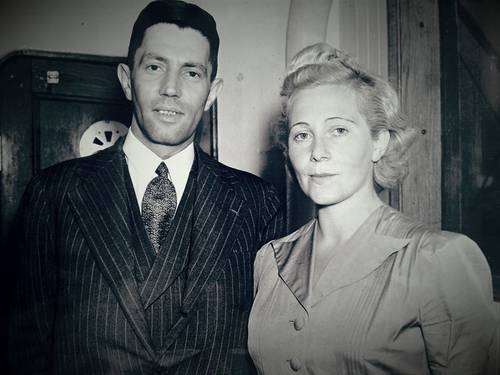 Rabbi Dr. Robert Serebrenik & wife, nee Julia Herzog on arrival in New York on June 21, 1941, aboard the S.S. Mouzinho from Lisbon, Portugal, leading the Luxembourg Congregation to the New World. Photo courtesy of Fausto Gardini
Rabbi Dr. Robert Serebrenik & wife, nee Julia Herzog on arrival in New York on June 21, 1941, aboard the S.S. Mouzinho from Lisbon, Portugal, leading the Luxembourg Congregation to the New World. Photo courtesy of Fausto Gardini
Tonight, as we commemorate the memory of those who perished in the Shoah, it is not appropriate to dwell too much on how most of the Jewish community of Luxembourg was saved from the Nazi machinery of death. There are other occasions when we can and we will celebrate this almost miraculous salvation. On this day, as difficult as it may be, it is perhaps more appropriate to focus only on what is the essence of the Holocaust, namely, the suffering and extermination of European Jewry.
After the transports to Lisbon ceased in the Spring of 1941, there remained roughly 947 Jews trapped in Luxembourg, a good portion of whom were elderly or ill. Deportations began in October 1941. Three hundred thirty four Jews were deported on October 11, 1941 to the Lodz ghetto. Of those, a large portion were Jews older than sixty years of age. In Lodz, the deportees either died or they were sent East to a variety of destinations, where all but eleven of them met their deaths. More transports headed East in April, June, and July of 1942. During those months, 228 Jews were deported to Theresienstadt and Auschwitz, of whom only eleven survived. A year later in June 1943, 108 more Jews were deported to Theresienstadt; only twenty survived. The Jews who were sent to Theresienstadt—the so-called "model Jewish ghetto" that the Nazis maintained in Czechoslovakia to impress the international Red Cross—either died there, or were in turn deported to Auschwitz for extermination.
In total, 670 Luxembourg Jews were hunted down by the Nazis and deported to extermination camps in Eastern Europe. Forty two of those survived their ordeal. Six hundred twenty eight never returned.
As I said earlier, tonight we have eyewitness testimony of what it was like in the extermination and concentration camps, but I do want to read to you a brief excerpt of testimony given by a Luxembourg Jew who was first deported to Theresienstadt and then to Auschwitz. His name was Alfred Oppenheimer, and he was President of the Jewish Consistoire, or Jewish council of Luxembourg. He was forty three years of age when he, his wife and his thirteen-year-old son were deported to Theresienstadt. His wife died there. He and his son were deported to Auschwitz on October 5, 1944. He testified at the Eichmann trial about his experiences. In his testimony, he describes a harrowing train journey in a sealed box car from Theresienstadt to Auschwitz. He also described the horror and suffering he endured for the two weeks he spent in Auschwitz before he was sent to Gleiwitz, which was a satellite camp of Auschwitz-Birkenau. In Gleiwitz, he described the back-breaking slave labor he endured. He describes in his testimony how he and another man, a Czech Jew, were caught with some potatoes that they had stolen from the kitchen. The Czech Jew had six or seven potatoes, but Oppenheimer had only managed to take one. The Czech Jew was hung by the SS, and left to strangle slowly and painfully. Although the noose was put around Oppenheimer’s neck, the SS at the last moment decided to merely torture him. They tied his arms around behind his back and hoisted him into the air, dislocating his shoulders. Oppenheimer fortunately passed out from the pain, but the next day, although seriously injured by the ordeal, he was forced to work along with everyone else. Otherwise, as Oppenheimer testified, “I would have been hung properly.”
Oppenheimer was sent on the death march from Auschwitz in December 1944, and after marching for nearly three days and nights through the snow, collapsed at the Blechammer concentration camp. Here is what he witnessed there, in his own words:
I could not walk any more, I told the two friends who had supported me throughout the whole long march that they should go on alone, because I really could no longer lift my legs, and by then I no longer cared where I died and I would rather die here than on the road. These two friends said that in that case they would prefer to stay with me rather than going with the transport, and we lay down on beds in another barracks and tried to sleep. The SS marched off, we knew that, with all the prisoners, with almost all of them, there were a few prisoners left, in this or that barracks, in our barracks there were perhaps another ten or fifteen prisoners, who were also incapable of marching with the rest and who had remained behind.
Suddenly, it was early in the afternoon and we had slept like the dead, someone rushed in and shouted, "Quick, quick, get a move on, the SS are coming back." I was so worked up and agitated that nothing hurt me any more, we all jumped up and the two friends next to me—I took them with me, the latrine was opposite, and we hid ourselves there in the latrine.
We watched through the cracks and saw what happened; naturally we were terribly worked up and we saw how shots were fired from above, they fired downwards, and the barracks—we could only see a small section through the cracks, but the three barracks which were immediately opposite us were set on fire... and the SS men then stationed themselves at machine guns and anything that ran out was shot down. Those who remained inside were burnt alive, of course.
Oppenheimer closed his testimony by reporting the following:
We received our orders that we would be deported from Theresienstadt about a certain time, I received mine on 4 October, as far as I can remember, and my boy—I had a thirteen or fourteen year old boy—he received his orders on the same day as I for the sixth [of October], and my boy—he was gassed in Auschwitz, I found that out on my birthday, on 11 October.
In closing, I want to read to you from the introduction of a book written by Paul Cerf, the son of one of the Luxembourg Jews who perished in Auschwitz. Paul Cerf, who died recently in Luxembourg, wrote a book entitled “Longtemps j’aurai memoire,” which I think is best translated, although not most literally translated, as “I will always remember.” Cerf, in his book, documents what happened to the Jews of Luxembourg under the Nazi occupation. He lists in this book the names and the fate of every one of the 628 Luxembourg Jews were deported to their deaths by the Nazis. It is our hope that in future years, we will read the names of each and every one of these 628 victims this night in this synagogue.
In his introduction, Paul Cerf writes the following:
628 Jewish deportees from the Grand-Duche [of Luxembourg] died in the deportation. 628 out of some six million who disappeared into the inferno of the concentration camps of the Second World War.
Mathematically speaking, an infinitesimal speck of dust.
But these were 628 destroyed human beings, 628 men, women and children.
628 lives brutally uprooted from their natural home from their land of exile. Why …[so many] years after these nameless horrors, do we recall this painful journey of Luxembourg Jews?
To honor their memory, first and foremost of all.
628 Jewish lives destroyed—3,000 Luxembourg Jews saved. And those who made it to these shores, founded this synagogue. So it is incumbent on us to remember them, all of them—as Primo Levi has called them “The Drowned and the Saved.” In particular, we remember tonight the Drowned, we who are so much the beneficiaries of the Saved of Luxembourg. Tonight we remember the Drowned.
I am going to ask slightly different question than the one underlying Paul Cerf’s remarks that I read earlier. What is the meaning of 3,000 Jews rescued in an ocean of six million dead? I don’t know the answer. All Jews must struggle with the legacy of the Shoah, with its meaning, or maybe with its absence of meaning—that is, after all why we are here tonight— to struggle with it. But to struggle with it is to first remember it. And to remember it, is first to tell it.
ACKNOWLEDGEMENTS: I gratefully acknowledge the personal recollections of Alice Levy and Jacques Lennon, who not only helped with this history, but lead me to pursue and find a transcript of Rabbi Serebrenik’s testimony at the Eichmann Trial. Many thanks to Professor Lou Henkin, who obtained the transcript, and to Yoel Neeman, Esq., who translated the transcript from its original Hebrew, and to Congregation Ramath Orah’s President, Leo Chester, who translated the German words in the transcript.
Wed, April 24 2024
16 Nisan 5784
Tonight's Sefirah Count Is 2
| היום שני ימים לעמר |
Today's Calendar
| Pesach |
| Shacharit : 9:00am |
| Mincha : 7:25pm |
| Maariv : 8:25pm |
| Havdalah : 8:30pm |
Tomorrow's Calendar
| Chol Hamoed Pesach |
| Shacharit : 7:00am |
Minyan sign up List
Please help us plan by signing up for the weekday minyan. Unless noted otherwise in the schedule on the left, minyan is at 7 a.m. Monday-Friday and at 8 a.m. on Sundays.
Today's Zmanim
| Alot Hashachar | 4:33am |
| Earliest Tallit | 5:09am |
| Netz (Sunrise) | 6:01am |
| Latest Shema | 9:27am |
| Zman Tefillah | 10:36am |
| Chatzot (Midday) | 12:54pm |
| Mincha Gedola | 1:29pm |
| Mincha Ketana | 4:55pm |
| Plag HaMincha | 6:21pm |
| Shkiah (Sunset) | 7:48pm |
| Havdalah | 8:30pm |
| Tzeit Hakochavim | 8:29pm |
| More >> | |
Join Our Mailing List
Office Hours
Monday–Friday 9:00 a.m.–2:00 p.m.
Email: info@ramathorah.org
Space Rental
Rent our space for a simcha—such as a bar or bat mitzvah, bris, or simchat bat—or for a party, meeting, or event. Click here for more information.



